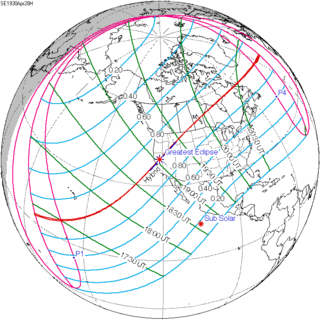| Solar eclipse of April 28, 1930 | |
|---|---|
| Type of eclipse | |
| Nature | Hybrid |
| Gamma | 0.473 |
| Magnitude | 1.0003 |
| Maximum eclipse | |
| Duration | 1 s (0 min 1 s) |
| Coordinates | 39°24′N 121°12′W / 39.4°N 121.2°W |
| Max. width of band | 1 km (0.62 mi) |
| Times (UTC) | |
| Greatest eclipse | 19:03:34 |
| References | |
| Saros | 137 (31 of 70) |
| Catalog # (SE5000) | 9351 |
A total solar eclipse occurred at the Moon's ascending node of orbit on Monday, April 28, 1930,[1] with a magnitude of 1.0003. It was a hybrid event, with only a fraction of its path as total, and longer sections at the start and end as an annular eclipse. A solar eclipse occurs when the Moon passes between Earth and the Sun, thereby totally or partly obscuring the image of the Sun for a viewer on Earth. A total solar eclipse occurs when the Moon's apparent diameter is larger than the Sun's, blocking all direct sunlight, turning day into darkness. Totality occurs in a narrow path across Earth's surface, with the partial solar eclipse visible over a surrounding region thousands of kilometres wide. The Moon's apparent diameter was near the average diameter because it occurred 7.2 days after apogee (on April 21, 1930, at 13:50 UTC) and 6 days before perigee (on May 4, 1930, at 19:50 UTC).[2]
Annularity was first visible in the eastern Pacific Ocean, then totality from California, Nevada, Oregon, Idaho and Montana, with annularity continuing northeast across the remainder of Montana and into central and eastern Canada and northern Labrador of the Dominion of Newfoundland (today's Newfoundland and Labrador in Canada). A partial eclipse was visible for parts of Hawaii, North America, and the northern Soviet Union.
- ^ "April 28, 1930 Total Solar Eclipse". timeanddate. Retrieved 3 August 2024.
- ^ "Moon Distances for London, United Kingdom, England". timeanddate. Retrieved 3 August 2024.
